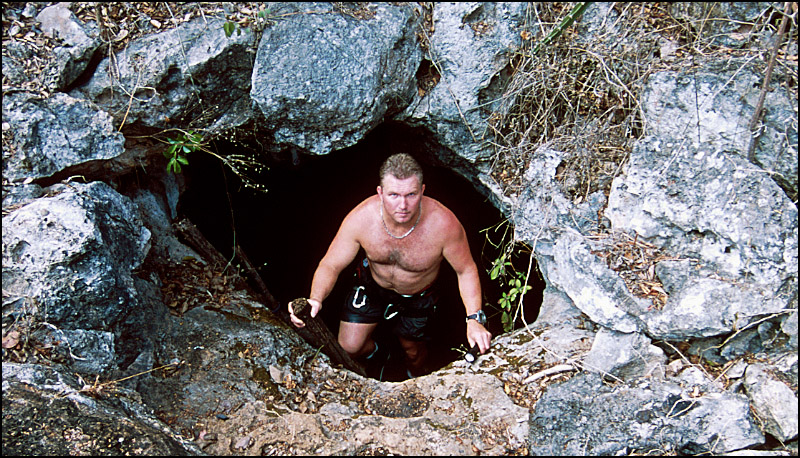

|
|
|
 |
| |
Over the years, it has be coming increasingly more difficult to explore caves untouched by human hands and unseen by human eyes without venturing deeper and deeper into unexplored territories.
Nevertheless, virgin caves were the destination of divers participating in "Yucatan Expedition 2001."
The expedition consisted of two teams that traveled to the Yucatan at two separate times. The first exploration team, which traveled to Mexico from March 27-April 1, visited the small village of Homun, located 60 miles east, southeast of Merida, the capital city of the state of Yucatan. This exploration team consisted of group coordinator Jim Rozzi, Mexican explorers Matt Matthes, Dan Lins, Roberto Hashimoto, Scott Carnahan, Benja Sacristan, Marike Jasper and Advanced Diver Magazine staff Curt and Linda Bowen. |
|
| |
 |
Above: Explorer Jon Bojar illuminates the large cavern zone of Cenote Tohoku.
Photo: C. Bowen N - 20º 44.156 W - 089º 15.694
Below: Cave explorer and publisher of Advanced Diver Magazine, Curt Bowen climbs out of a small cave. |
|
|
|
 |
| |
This region of the Yucatan is composed of a giant, limestone bed, which was perfect for cave formation. The Yucatan State of Ecology has documented over 2,000 cenotes in this region and believes 3,000 to 5,000 are yet to be discovered. Only about one percent of these cenotes has ever been explored below the water line.
For five days, this team's efforts concentrated on discovering, photographing and documenting as many cenotes as possible within the short time period. These attempts were hampered due to the fact that 90 percent of the cenotes discovered required rope rappelling and climbing skills to obtain access.
After more than five days of exploration, the team discovered and documented 38 new cenotes. Many of these cenotes contained significant flow stone forma- tions, blind cave inhabitants and some Mayan artifacts. No linear cave passage was found during this phase of the expedition with the exception of one possible deep sink hole with unexplored passage appearing to be running at a depth of 240 feet that would require a return trip with proper helium and decompression mixes. |
|
 |
Above: Artist rendition of the Cenote Och 1 cave system: Although short in linear passage, this cave appears quite impressive due to its passage's immense size, measuring between 20- 40 feet wide and 80 to 140 feet tall. Illustration C. Bowen
Below: A large cat skull discovered in a cenote not far from Och 1. |
|
|
 |
| |
On May 30, a second team returned to the Homun area for eight days to continue the exploration. Advanced Diver Magazine's Curt Bowen and Leroy McNeal along with cave explorers Jon Bojar, Jason Richards and Chip Wauze joined the team. National Geographic and Imax producer Wes Skiles along with his production team, connected with this team for the first couple days to shoot high definition video footage of some unique discoveries found on the first team's expedition. Also participating in the expedition were Playa Del Carmen's Protech owners and explorers Matt Matthes and Scott Carnahan.
The second phase of the Yucatan 2001 expedition provided two outstanding discoveries: cenote Och 1 and cenote Tuchen. Cenote Och 1, located just outside the Village of Homun, started as a typical round cenote entrance with a 40-foot rappel to the water's surface. Explorer Jon Bojar completed the first solo reconnaissance sidemount dive into the system. Returning after 25 minutes to the surface, Jon described the giant cave passage as 20 to 40 feet wide and 80 to 100 feet tall with very dark walls. Advanced Diver's Curt Bowen grabbed another survey reel and his sidemount equipment and descended into the cenote. Continuing to the end of the line placed by Jon, the tunnel emptied into a very large junction room with the main tunnel continuing to the left. Peeling off the survey line, the large tunnel continued for another 200 feet until it ended in an immense room. This room measured 100 feet in diameter and 140 feet tall.
It contained a large air dome at its surface and dropped to a maximum depth of 123 feet. While gathering survey data on the way out of the cave, Bowen noticed another tunnel on his left. Attaching his survey reel to the primary line, he found that this tunnel continued through a large passage with a sloping floor until it came to a prompt end some 200 feet from the tie off. The team determined that future exploration of the site was needed to fully research and document the cenote.
|
|
| |
 |
Above: Jason Richards and Jon Bojar explore the cavern zone on Cenote Tuchen.
Below: Tailless Whipscorpion (Tarantula spp.)
Found in the dry cavern zones of the central Yucatan cenotes, these giant whipscorpions can span up to eight inches in diameter with their legs extended. Giant, nonpoisonous and arachnid-related, whipscorpions rely on stealth and quickness to capture their prey with specially-designed pinchers. |
|
|
|
 |
 |
Above: Artistic rendition of the cave system Tuchen: The erosive effects of water have created impressive flowstone formations, giant columns and immense rooms. Illustration: Curt Bowen
N - 20º 41.964 W - 089º 14.768 |
|
|
| |
Cenote Tuchen (above map) was located down a dirt road several miles from Homun through the Yucatan jungle. This cenote's entrance drops 25 feet into a dry pit and into a large cavern zone. Jason Richards conducted the first reconnaissance dive and found an extremely large passage, impressive flowstone formations and a large dry air dome chamber. Passing the air dome, Jason reeled out knotted line down a massive tunnel leading deeper into the unexplored cenote. Once his exploration reel ran out of line, Jason returned to the exit with the news of his discovery.
Jon Bojar and Curt Bowen gathered more knotted survey line and returned to the end of Jason's line. Tying off, they continued down the massive tunnel. Dipping under a low ceiling the divers entered into what they called the White Room. The water visibility increased to more than 150 feet with a slight blue tinge. This giant room stretched more than 100 feet wide and 150 feet long. Massive white limestone breakdown filled the floor as the team's 18-watt Sartek HID lights flooded the room. Noticing a water tunnel on the left floor of the white room, the team dropped into a 20-foot diameter solution tube running towards the east at a depth of 120 feet. The water tunnel continued for more than 300 feet and abruptly ended in a small white room. Turning back, the team gathered the survey data as they exited the cave. Several tunnels and possible continued leads were noted upon the team's exit. Much more exploration of this system is required. Overall, the two teams explored, surveyed and documented over 50 new cenotes.
|
|
| |
 |
Above: Jason Richards prepares for a dive into Cenote Tuchen.
Below: "Homun Bob" A starving little puppy we nursed back to life. |
|
|
|
 |
|
 |
|
| |
|